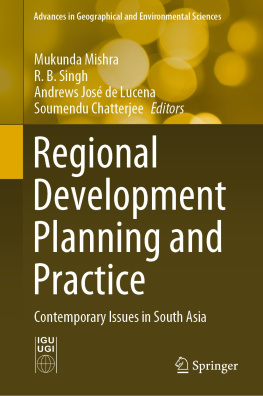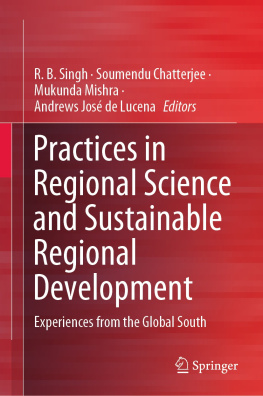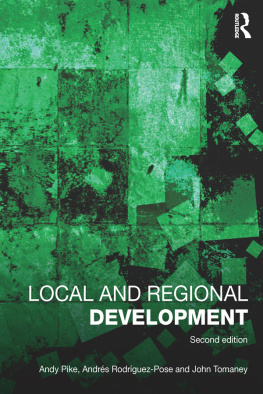Routledge Revivals
British Regional Development Since World War I
First published in 1981, British Regional Development Since World War I presents a comprehensive and balanced introduction to the problems of regional development in Britain. Since World War I it has been possible to talk of Britain as two nations, a prosperous South including the Midlands, and a poor North. Christopher Law examines the nature and causes of this division, including impact of industrial structure, Londons role as capital in the spatial economy, and the influence of better environments on development. This valuable study will be an essential read for anyone interested in any aspect of regional development and development studies in the last ninety years.
British Regional Development Since World War I
by Christopher M. Law
First published in 1980
by David & Charles (Publishers) Ltd.
First Published as a University Paperback in 1981
by Methuen & Co. Ltd.
This edition first published in 2021 by Routledge
2 Park Square, Milton Park, Abingdon, Oxon, OX14 4RN
and by Routledge
605 Third Avenue, New York, NY 10017
Routledge is an imprint of the Taylor & Francis Group, an informa business
1980 Christopher M. Law
All rights reserved. No part of this book may be reprinted or reproduced or utilised in any form or by any electronic, mechanical, or other means, now known or hereafter invented, including photocopying and recording, or in any information storage or retrieval system, without permission in writing from the publishers.
Publishers Note
The publisher has gone to great lengths to ensure the quality of this reprint but points out that some imperfections in the original copies may be apparent.
Disclaimer
The publisher has made every effort to trace copyright holders and welcomes correspondence from those they have been unable to contact.
A Library of Congress record exists under LCCN: 81016759
ISBN 13: 978-1-032-05331-8 (hbk)
ISBN 13: 978-1-003-19708-9 (ebk)
ISBN 13: 978-1-032-05332-5 (pbk)
CHRISTOPHER M. LAW
British Regional Development Since World War 1
METHUEN
London and New York
for Elizabeth
First published in 1980 by
David & Charles (Publishers) Ltd
Brunei House, Newton Abbot, Devon
First published as a University Paperback in 1981 by
Methuen & Co. Ltd
11 New Fetter Lane, London EC4P 4EE
Published in the USA by
Methuen & Co.
in association with Methuen, Inc.
733 Third Avenue, New York, NY 10017
1980 Christopher M. Law
Printed in Great Britain by
J. W. Arrowsmith Ltd, Bristol
All rights reserved. No part of this book may be reprinted or reproduced or utilized in any form or by any electronic, mechanical or other means, now known or hereafter invented, including photocopying and recordings or in any information storage or retrieval system,! without permission in writing from the publishers.
British Library Cataloguing in Publication Data
Law, Christopher M. British regional development since World War
1.(University paperbacks; 750) 1. Regional planningGreat BritainHistory
2. Great BritainEconomic policy
I. Title
330.941082HT395.G7
ISBN0416323103
Contents
The topic of British regional development and regional problems has received a great deal of attention in the last twenty years. A whole industry has developed consisting of research centres, learned organisations and a veritable flood of publications. In universities and polytechnics students in economics, geography, planning and allied subjects are provided with courses involving lengthy discussions on Britains regional problems. For the last twelve years the author has provided such a course, and it is out of such an experience that the idea for this book has arisen. Although there is a vast literature on the subject, most of the works are of a specialised nature dealing with particular regions, limited periods or selected aspects of the topic such as manufacturing industry or offices. However, the intending student of the subject requires a broad introduction to the subject to enable him to move from the general to the particular. The aim in writing this book has been to provide a comprehensive and balanced introduction to the problems of regional development in Britain. In order to give sufficient historical perspective to these problems, the study has been taken back to the end of World War I which to a certain extent was a turning point for regional development. It will be obvious to the reader that the topic thus defined is vast and worthy not of one but several books. The only limitation which has been imposed on the work is to concentrate attention on interregional as opposed to intra-regional development. Thus we are concerned with the differences in growth between say the South East and Scotland rather than the pattern of change within these regions. Even with this limitation the topic is still vast, and it will be easy for specialists to say that there is not enough on this or that aspect. However, I hope that the overall impression is one of balanced coverage with sufficient references to enable specialist interests to be pursued.
The idea for this book has matured over several years and its writing would not have been possible without study leave from the University of Salford, to whom grateful acknowledgement is made. I am also grateful to the editor of the series, Professor Dick Lawton for his helpful comments. Acknowledgement is also made to the editor of Social Trends for permission to reproduce the diagram in . I should also like to thank Janet Richardson, Marie Partington and Julie Jones for typing the manuscript and Christine Minister and Gustav Dobrzynski for drawing the maps. Finally to my wife, Elizabeth, and children, Katherine and Nicholas, my thanks for their tolerance of my work which so often transforms holidays into field trips.
The contrast between regional development in Britain in the nineteenth and twentieth centuries is well known: in the nineteenth century economic activity was strongly attracted towards the coalfields found mainly in the northern and western parts of the country, although London as national and empire capital continued to grow; whilst in the twentieth century spontaneous economic growth has mainly occurred in the South East and Midlands. The reasons often given for this change include the lessening importance of coal consequent upon the growth of new forms of energy such as electricity and oil, and the decline in the relative cost of transport, encouraging market as opposed to material orientation of industries. However, whilst these factors explain the reduction in the restraints upon location, they hardly account for the new patterns of growth and its absence in the important nineteenth-century industrial areas. Accordingly further factors have been suggested for the twentieth-century importance of the South East and Midlands including the availability of requisite skills, ancillary industries, the growth of government spending and employment, the location of the wealthy and affluent requiring new products, the concentration of financial institutions in London, and so on. To explain the absence of spontaneous growth in other parts of the country, other factors have been alluded to such as the overdependence on declining industries, poor economic structure, lack of entreprenurial initiative and poor physical environment. With such a long list of factors it could hardly be suggested that they are not relevant; but how important, and at what time? It is the aim of this book to describe more fully the process of regional development in the United Kingdom and make a more precise evaluation of the factors involved. The main theme is the difference in economic prosperity between the major regions of the United Kingdom, and differences within regions will be largely but not completely ignored.













